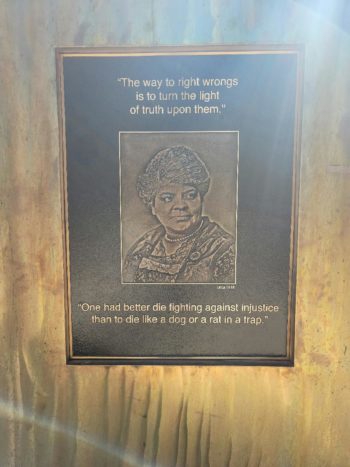The Ida B. Wells Monument was unveiled Wednesday at 37th & Langley among a crowd of spectators, public officials, Bronzeville, and former Ida B. Wells Home residents. The 20-foot-tall sculpture “Light of Truth” was designed by Chicago artist and sculptor Richard Hunt. The monument has three bronze columns, with spirals, coils, Ida B. Wells biographical facts, and one of her famous quotes, “The way to right wrongs is to turn the light of truth upon them.” The monument is the first in the City of Chicago to honor a black woman.
The monument was commissioned by the Ida B. Wells Commemorative Committee. Michelle Duster, the great-granddaughter of Ida B. Wells, had to let the ceremony sink in that after 13 years of support from donors and hard work, the monument has become a reality.
“After working on this project for over a decade, the reality that it is finished is still sinking in. I realized the other day that if the project were a child, it would be graduating from 8th grade now. I truly hope that the monument will be a source of pride for the Bronzeville neighborhood where my great-grandmother lived for over 35 years, as well as the whole city, state, and nation. Ida B. Wells spent her entire adult life fighting for justice and equality. This awe-inspiring monument, created by world-renowned Chicago native Richard Hunt, should inspire people to see their own power and continue her work” says Michelle Duster.
 At the Ida B. Wells Dedication Ceremony, violinist Windy Indie open the program with her performance of the hymn “Lift Every Voice & Sing. Bryan Stevenson, of the Equal Justice Initiative, actress Tika Sumpter and Mariame Kaba, organizer & author, paid virtual tributes and congratulations on the historic moment. Mayor Lori Lightfoot, Cook County Board President Toni Preckwinkle, 4th Ward Alderwoman Sophia King, and journalist Nikole Hannah-Jones made remarks about the life and legacy of Ida B. Wells and the lack of monuments and statues honoring black women.
At the Ida B. Wells Dedication Ceremony, violinist Windy Indie open the program with her performance of the hymn “Lift Every Voice & Sing. Bryan Stevenson, of the Equal Justice Initiative, actress Tika Sumpter and Mariame Kaba, organizer & author, paid virtual tributes and congratulations on the historic moment. Mayor Lori Lightfoot, Cook County Board President Toni Preckwinkle, 4th Ward Alderwoman Sophia King, and journalist Nikole Hannah-Jones made remarks about the life and legacy of Ida B. Wells and the lack of monuments and statues honoring black women.
“It’s important who we celebrate and who we choose to celebrate. I feel Ida B. Wells’ spirit here today,” says Ald. King.
“We are all standing on her shoulders. The ground that she walked on, the legacy, and the history that she carved into this country. We are the beneficiaries of her life and legacy, and we dare not forget that” says Mayor Lightfoot.
“What’s troubling in this country is the extent to which we honor not just a very small segment of our population, white men, but white men who were slaveholders. You know if you think about Washington Park and Jackson Park, they’re named after presidents of the United States, for sure. But slaveholding presidents of the United States, which I would argue is an affront to all of us. What is this? Why are we lifting up slaveholders? So, I’m very grateful to be part of a celebration that lifts up a fighter for justice,” says Toni Preckwinkle.
“We are about to unveil a monument to a black woman who actually did believe in the ideas of this country. We create monuments because we want monuments to tell us publicly how we see ourselves as a nation. So, the fact that across this country we don’t have monuments to the enslaved, but we have monuments to those that enslaved them. Monuments to enslavers, bigots and colonizers are coming down all across the country. We have to not leave an empty space there. We have fill in those spaces with the spaces of the true Americans who actually fought for the ideas of liberty and freedom, and that’s what we are doing today with the Ida B. Wells monument,” says Hannah-Jones.
The great-grandchildren of Ida B. Wells, Dan, and Michelle Duster, were emotional about the overwhelmed turn-out for the dedication ceremony for their great-grandmother.
“We are all here to celebrate her HERstoric moment,” says Michelle Duster.
“Rosa Parks was the mother of the Civil Rights Movement, Fannie Lou Hamer, Sojourner Truth were the grandmothers, Ida B. Wells was the great-grandmother, and it goes on and on. To have a monument that can tell people her story and not just her name is powerful,” says Dan Duster.
Wells was born in Holly Springs, MS, in 1862. Wells and two of her siblings moved to Memphis after their parents died from the Yellow Fever Epidemic in 1878.
Wells became part owner of the Memphis newspaper Free Speech and Headlight to denounce racial injustice. Wells began her anti-lynching crusade when three of her friends were beaten and lynched for defending their Memphis grocery store on March 9, 1892.
Wells left Memphis and moved to Chicago. In 1895, Wells married journalist Ferdinand Lee Bartnett. From 1919 to 1929, the couple lived at 3624 S. Martin Luther King Drive, Chicago. The Ida B. Wells-Barnett Houe is a National Historic Landmark. Wells died on March 25, 1931, and is buried at Oak Woods Cemetery in Chicago.
Tammy Gibson is a black history traveler and author. Find her on social media at @SankofaTravelHr.